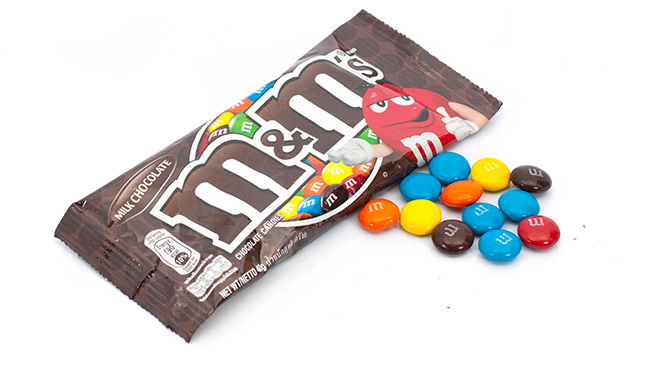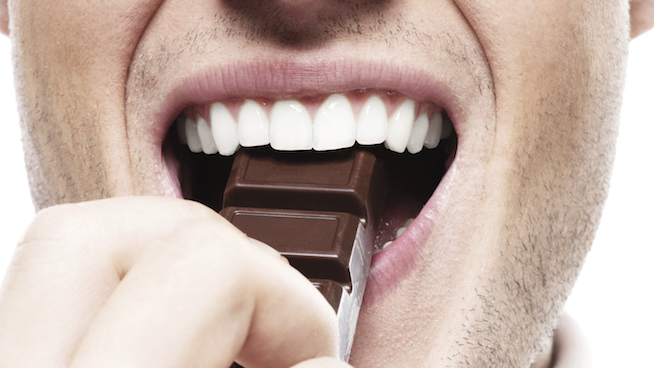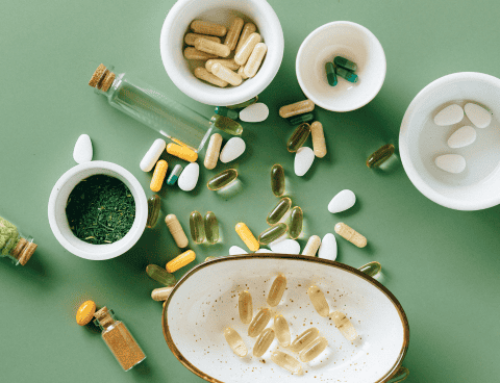3 Ingredients That Ruin Your Favorite Valentine’s Day Chocolates
You know that candy and chocolates aren’t healthy, but you probably don’t know that the sweet treat you give your special someone this Valentine’s Day may contain a potential carcinogen. Or that popular candies marketed with cartoon characters contain ingredients linked with behavior problems in kids.
A large number of chocolate candies sold in the U.S. contain questionable additives, according to the Center for Science in the Public Interest and other watchdog groups. Some of those ingredients have been banned in Europe and the United Kingdom.
The good news is that times are changing. In fact, as you’ll read below, two of the biggest U.S. chocolate manufacturers have announced plans to make major changes to their formulations—including one announcement just this week—in an attempt to make their ingredient lists more natural. Those changes will take years, however—and at least one questionable ingredient will be left unaddressed. Until it is, and until the other changes take effect, here are three ingredients you’ll find in popular chocolate treats that you may want to steer clear of.
TBHQ

Stands for: Tertiary Butylhydroquinone
What it’s in: Reese’s Peanut Butter-Filled Hearts, Butterfinger Hearts
Why it’s used: TBHQ is designed to prevent a product from turning rancid, thereby extending its shelf life.
What’s the problem: Lab tests showed that TBHQ increased the incidence of tumors in rats, which is why it landed on the Center for Science in the Public Interest’s list of foods to avoid.
“Your risk of cancer is quite small, but why knowingly consume a carcinogen?” says CSPI’s senior scientist Lisa Lefferts. “There are other carcinogens in our environment that are impossible to avoid, but this is one you can.”
Other potential risks with ingesting TBHQ have been reported: vision disturbances, and a widely reported but difficult to source saying the ingestion of 5 grams in an industrial setting can cause death. (STACK was unable to find an incidence of this actually happening.)
Some context, however: The FDA places stringent regulations on TBHQ use, mandating that the chemical not account for more than .02 percent of a food’s makeup. So the amount we’re talking about here is probably very small.
Artificial Food Colorings

Stands for: Red 40, Blue 1, Blue 2, Yellow 5, Yellow 6
What they’re in: M&M’s
Why they’re used: To give the candy treats their colorful outer shell.
What’s the problem: A number of studies—and several heartbreaking testimonials from moms—indicate artificial food coloring can make kids hyperactive. Problems have been observed both in kids already diagnosed with ADHD and those who did not have the condition. And it doesn’t take a lot to set off the issue.
“The dose that is needed to trigger adverse reactions varies depending on how sensitive the person is,” Lefferts says. “Some kids aren’t sensitive at all. Some kids are really sensitive. One study found some children reacted to just 1 mg of yellow 5. A packet of plain M&Ms contains 13.4 mg of dyes, according to FDA’s tests.”
The CSPI believes the problems caused by artificial food dyes are widespread and costly. The organization estimates more than 512,000 kids have adverse reactions to the dyes each year, and the cost of treating them reaches into the billions. That’s part of the reason why these dyes are banned in the European Union and United Kingdom. The British version of M&M’s, called Smarties, do not use artificial coloring, instead opting for radish, lemon and red cabbage extracts.
Changes ahead: This week Mars, the maker of M&M’s and many other food items, announced that they will be removing all artificial colors from foods within five years. The move is part of a trend among food companies to remove artificial flavors and colors, but it comes after years of prodding.
“We are thrilled that Mars will be removing synthetic food dyes,” Lefferts says. “We hope other companies follow suit.”
Note: this doesn’t mean you should start eating more M&M’s because they no longer contain a questionable ingredient that appears to make some kids hyperactive. The candy is still filled with fat, sugar and empty calories, and should be consumed rarely it at all.
PGPR

Stands for: Polyglycerol Polyricinoleate
What it’s in: Seemingly every low-cost chocolate (we found it in Hershey’s Special Dark and Milk Chocolate Hearts, Reese’s Peanut Butter-Filled Hearts, Kit Kats, Twix, Snickers, and M&M’s)
Why it’s used: PGPR is an emulsifier, preventing the separation of fat and water within the product. Hershey’s says the additive was first used in chocolate in 1952.
What’s the problem: This one isn’t a health hazard—a government analysis showed that a person could take in up to 10 grams a day without adverse effects. The real problem with its use, according to chocolate experts, is taste.
“Chemical additives like this are designed to help use chocolate in mouldings and running through machines, mainly by mimicking the effect of cocoa butter, allowing the manufacturer to replace that expensive cocoa butter with cheaper fats,” says Jennifer Earle, a chocolate consultant. “You won’t find PGPR in high end chocolate.”
Changes ahead: Late last year, Hershey’s announced it would be phasing out PGPR within the next few years. In the announcement, the brand said it would up the amount of cocoa butter in order to replace the additive. But as of this week, several Hershey’s products—including all of the Valentine’s Day candy STACK found at a local grocery store—contained PGPR. The company announced a plan to simplify its ingredients list a year ago, saying the process could take years.
The Takeaway
Candy and chocolate are an indulgence. If you treat them as such and consume them rarely, you will probably be fine. Your body should be able to process the ingredients listed above without incident, in the same way it can handle occasional doses of fat, sugar and empty calories these candies deliver. (Although note the small tolerance threshold for artificial dyes among some kids that Lefferts mentions above.) But if these additives carry a certain “ick” factor for you—and clearly, they do for a number of people—then keep an eye out for them on ingredients lists this Valentine’s Day. Although major chocolate manufacturers are making changes, it may be a while before they take effect.
RECOMMENDED FOR YOU
MOST POPULAR
3 Ingredients That Ruin Your Favorite Valentine’s Day Chocolates
You know that candy and chocolates aren’t healthy, but you probably don’t know that the sweet treat you give your special someone this Valentine’s Day may contain a potential carcinogen. Or that popular candies marketed with cartoon characters contain ingredients linked with behavior problems in kids.
A large number of chocolate candies sold in the U.S. contain questionable additives, according to the Center for Science in the Public Interest and other watchdog groups. Some of those ingredients have been banned in Europe and the United Kingdom.
The good news is that times are changing. In fact, as you’ll read below, two of the biggest U.S. chocolate manufacturers have announced plans to make major changes to their formulations—including one announcement just this week—in an attempt to make their ingredient lists more natural. Those changes will take years, however—and at least one questionable ingredient will be left unaddressed. Until it is, and until the other changes take effect, here are three ingredients you’ll find in popular chocolate treats that you may want to steer clear of.
TBHQ

Stands for: Tertiary Butylhydroquinone
What it’s in: Reese’s Peanut Butter-Filled Hearts, Butterfinger Hearts
Why it’s used: TBHQ is designed to prevent a product from turning rancid, thereby extending its shelf life.
What’s the problem: Lab tests showed that TBHQ increased the incidence of tumors in rats, which is why it landed on the Center for Science in the Public Interest’s list of foods to avoid.
“Your risk of cancer is quite small, but why knowingly consume a carcinogen?” says CSPI’s senior scientist Lisa Lefferts. “There are other carcinogens in our environment that are impossible to avoid, but this is one you can.”
Other potential risks with ingesting TBHQ have been reported: vision disturbances, and a widely reported but difficult to source saying the ingestion of 5 grams in an industrial setting can cause death. (STACK was unable to find an incidence of this actually happening.)
Some context, however: The FDA places stringent regulations on TBHQ use, mandating that the chemical not account for more than .02 percent of a food’s makeup. So the amount we’re talking about here is probably very small.
Artificial Food Colorings

Stands for: Red 40, Blue 1, Blue 2, Yellow 5, Yellow 6
What they’re in: M&M’s
Why they’re used: To give the candy treats their colorful outer shell.
What’s the problem: A number of studies—and several heartbreaking testimonials from moms—indicate artificial food coloring can make kids hyperactive. Problems have been observed both in kids already diagnosed with ADHD and those who did not have the condition. And it doesn’t take a lot to set off the issue.
“The dose that is needed to trigger adverse reactions varies depending on how sensitive the person is,” Lefferts says. “Some kids aren’t sensitive at all. Some kids are really sensitive. One study found some children reacted to just 1 mg of yellow 5. A packet of plain M&Ms contains 13.4 mg of dyes, according to FDA’s tests.”
The CSPI believes the problems caused by artificial food dyes are widespread and costly. The organization estimates more than 512,000 kids have adverse reactions to the dyes each year, and the cost of treating them reaches into the billions. That’s part of the reason why these dyes are banned in the European Union and United Kingdom. The British version of M&M’s, called Smarties, do not use artificial coloring, instead opting for radish, lemon and red cabbage extracts.
Changes ahead: This week Mars, the maker of M&M’s and many other food items, announced that they will be removing all artificial colors from foods within five years. The move is part of a trend among food companies to remove artificial flavors and colors, but it comes after years of prodding.
“We are thrilled that Mars will be removing synthetic food dyes,” Lefferts says. “We hope other companies follow suit.”
Note: this doesn’t mean you should start eating more M&M’s because they no longer contain a questionable ingredient that appears to make some kids hyperactive. The candy is still filled with fat, sugar and empty calories, and should be consumed rarely it at all.
PGPR

Stands for: Polyglycerol Polyricinoleate
What it’s in: Seemingly every low-cost chocolate (we found it in Hershey’s Special Dark and Milk Chocolate Hearts, Reese’s Peanut Butter-Filled Hearts, Kit Kats, Twix, Snickers, and M&M’s)
Why it’s used: PGPR is an emulsifier, preventing the separation of fat and water within the product. Hershey’s says the additive was first used in chocolate in 1952.
What’s the problem: This one isn’t a health hazard—a government analysis showed that a person could take in up to 10 grams a day without adverse effects. The real problem with its use, according to chocolate experts, is taste.
“Chemical additives like this are designed to help use chocolate in mouldings and running through machines, mainly by mimicking the effect of cocoa butter, allowing the manufacturer to replace that expensive cocoa butter with cheaper fats,” says Jennifer Earle, a chocolate consultant. “You won’t find PGPR in high end chocolate.”
Changes ahead: Late last year, Hershey’s announced it would be phasing out PGPR within the next few years. In the announcement, the brand said it would up the amount of cocoa butter in order to replace the additive. But as of this week, several Hershey’s products—including all of the Valentine’s Day candy STACK found at a local grocery store—contained PGPR. The company announced a plan to simplify its ingredients list a year ago, saying the process could take years.
The Takeaway
Candy and chocolate are an indulgence. If you treat them as such and consume them rarely, you will probably be fine. Your body should be able to process the ingredients listed above without incident, in the same way it can handle occasional doses of fat, sugar and empty calories these candies deliver. (Although note the small tolerance threshold for artificial dyes among some kids that Lefferts mentions above.) But if these additives carry a certain “ick” factor for you—and clearly, they do for a number of people—then keep an eye out for them on ingredients lists this Valentine’s Day. Although major chocolate manufacturers are making changes, it may be a while before they take effect.












